Fictiv’s Global Manufacturing Network Now Includes Sheet Metal, Die Casting, and Compression Molding
Fictiv, the San Francisco-based, digital manufacturing network, has added three new manufacturing capabilities to its repertoire: sheet metal forming, die casting, and compression molding. This brings Fictiv’s total number of capabilities to seven, with the other four being injection molding, additive manufacturing (AM), CNC machining, and urethane casting.
Compression molding is used for polymer composite materials, entailing the use of heated molds to press the feedstock into the designated shape. Die casting involves a few different methods for filling molds with liquid metal, in a process similar to injection molding. Sheet metal forming utilizes a variety of techniques for changing the shape of thin metal sheets that are still in their solid state, to create end-products with complex geometries.
AM can be incorporated with all of these techniques, as well as with all of the other three non-AM processes in Fictiv’s wheelhouse. Specifically, 3D printing enhances the ability of manufacturers to create complex molds, a process aided in Fictiv’s case by the 3D visualization tools the company offers.

In a press release about Fictiv’s offering of three additional manufacturing techniques, Fictiv’s CEO and co-founder, Dave Evans, said, “With the rollout of these new capabilities, we are making it even easier for our customers to source the mechanical parts they need for an entire product, with the speed and quality they have come to trust and rely on from Fictiv. As manufacturing leaders seek to expand margin, decrease BOM [bill of material] costs, and reduce supply chain risks in 2024, Fictiv is fully-stacked and well-positioned as a strategic custom manufacturing partner to help them realize their goals.”
Michelle Kim, CEO of haircare product company m’Chel and a Fictiv customer, said, “With Fictiv, we know our mechanical parts are with a safe pair of hands. We choose Fictiv because of their commitment to quality over everything. They are a true partner for us, and so the prospect of being able to source and produce a wide variety of the mechanical parts we need through Fictiv is reassuring.”

In 2023, of course, more or less everyone in the business world started to realize that the intersections between tech and industry are culminating in AI. Manufacturers are just starting to scratch the surface in terms of the connections. But it is worth noting that platforms like Fictiv were already there, with AI at the core of the company’s business model, for instance as the driver of Fictiv’s quote-to-order capabilities.
Even this relatively modest deployment of AI — “modest” compared to the visions for AI’s future role in digital manufacturing — gives networks like Fictiv an incalculable advantage for tapping the future potential. The most important thing to keep in mind is that since it is already central to the company’s business model, Fictiv will never have to go back and reverse engineer a role for AI, but can continue building on the foundation and stay apace with AI’s evolution.
Along these lines, digital manufacturing platforms should become more and more integral to the successful deployment of AM and all other digital manufacturing technologies, the more that the world at-large embraces AI. Down the road, this should make it easier for users to optimize the connections between all the various manufacturing technologies Fictiv provides access to, continuously opening up greater possibilities for the combinations of those processes.
Images courtesy of Fictiv
Subscribe to Our Email Newsletter
Stay up-to-date on all the latest news from the 3D printing industry and receive information and offers from third party vendors.
Print Services
You May Also Like
3D Printing Financials: Prodways Ends 2024 with a Profit
After a tough couple of years, Prodways (EPA: PWG) is starting to bounce back. The French 3D printing company finally made a profit in 2024, improved its operating performance, and...
Blue Origin & Auburn University Use EOS M290 to Study Copper 3D Printing
Blue Origin, the commercial space company built off of investments from Amazon founder Jeff Bezos, has donated two EOS M290 powder bed fusion (PBF) printers to Auburn University’s National Center...
Rocket Lab to Acquire Restructured Laser Communications Provider Mynaric AG
Rocket Lab USA, the Long Beach-based, end-to-end space services company that specializes in producing rockets with additive manufacturing (AM), has announced plans to acquire Mynaric AG, a German provider laser...
3D Printing Financials: Stratasys Ends 2024 with Cost Cuts and Growth Plans
Stratasys (Nasdaq: SSYS) has wrapped up 2024 with stronger margins but a full-year net loss. The polymer 3D printing leader navigated a year of economic headwinds, restructuring efforts, and shifting...



























